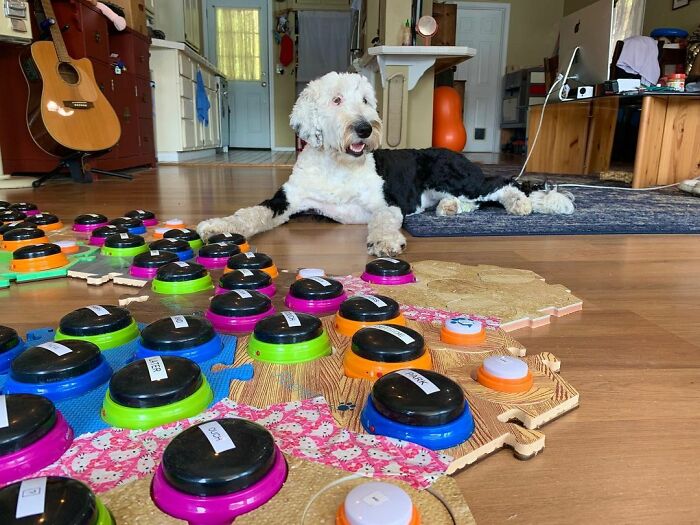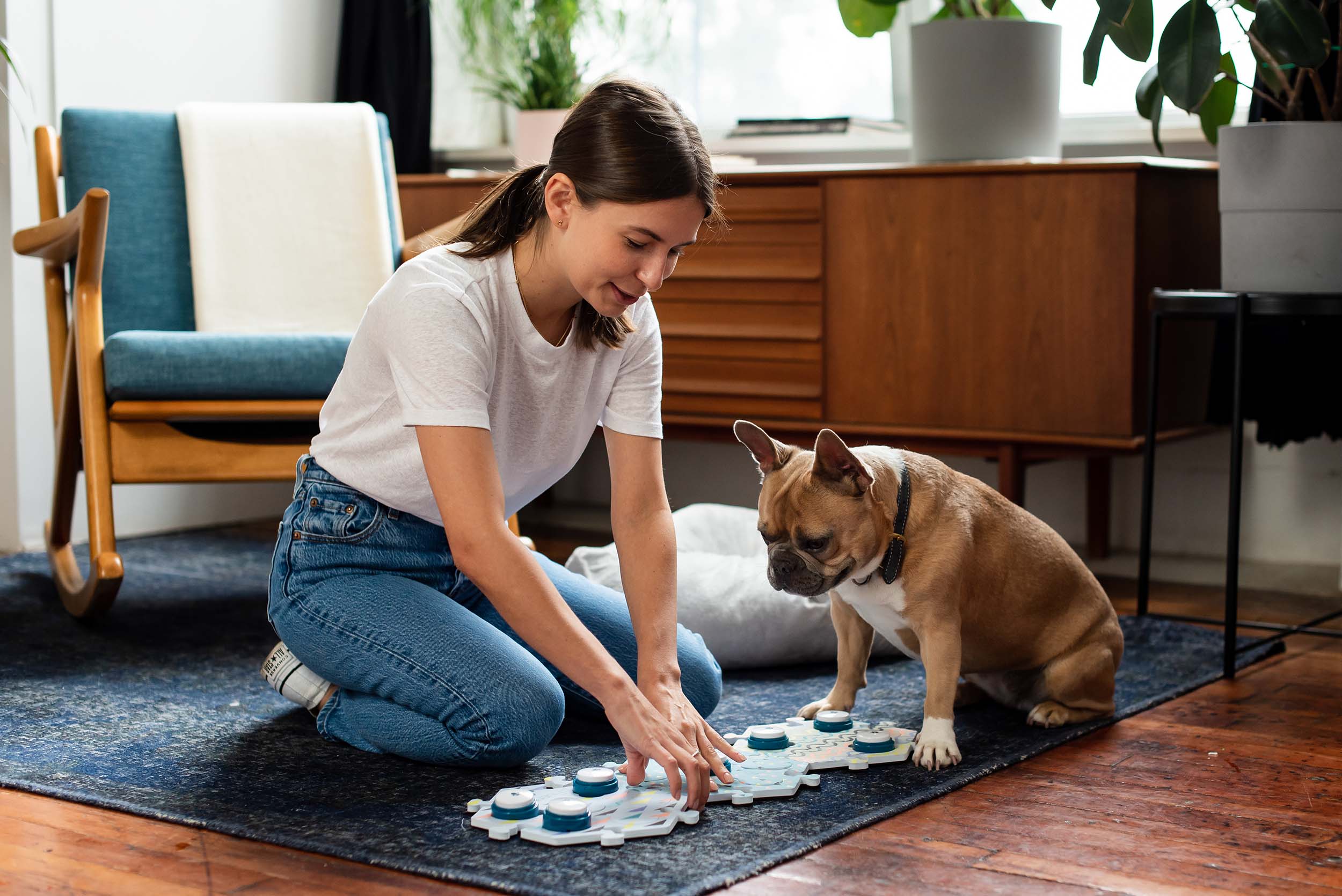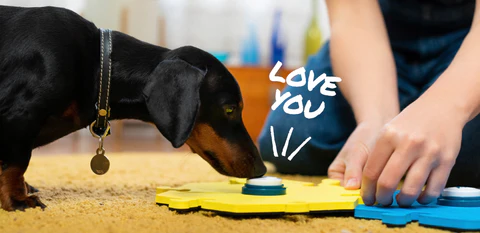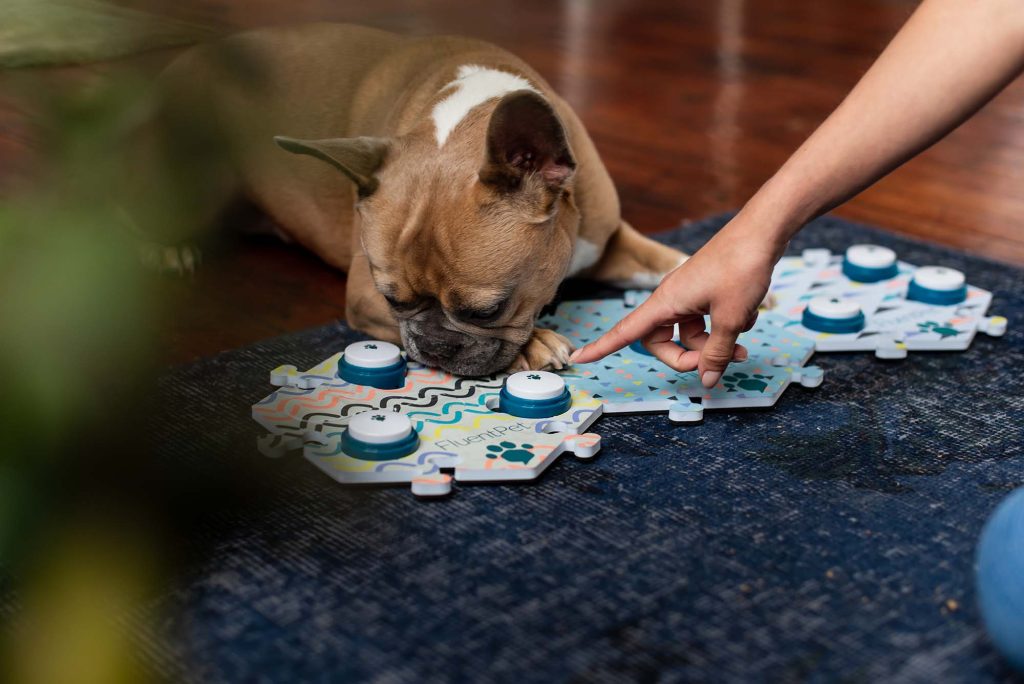Delving into the delightful domain of dog buttons, we uncover a fascinating field of communication that enhances canine companionship.
Dog buttons have emerged as an innovative tool for fostering effective and efficient interaction between humans and their furry friends. These ingenious devices enable dogs to express their needs, desires, and emotions through a series of pre-programmed buttons that emit distinct sounds when pressed.
This article explores the benefits of incorporating dog buttons into daily communication routines, shedding light on how they can revolutionize the way we understand our pets’ thoughts and feelings. Furthermore, it provides practical guidance on training dogs to utilize these buttons effectively, emphasizing the importance of understanding different button functions and teaching basic commands through this novel method.
With real-life anecdotes showcasing the success stories of dogs using dog buttons, we witness how this technology fosters emotional intelligence in canines while facilitating behavioral training. Engaging with this informative discourse will equip readers with valuable insights for implementing dog buttons successfully in their own lives, paving the way for improved understanding and mutual service between humans and their four-legged companions.
Key Takeaways
- Dog buttons enhance communication between humans and dogs.
- Training dogs to use dog buttons is important for effective communication.
- Dog buttons strengthen the bond and trust between dogs and their owners.
- Dog buttons can be used to teach basic commands to dogs.
The Benefits of Dog Buttons in Communication

The use of dog buttons in communication offers numerous advantages that can enhance the understanding and interaction between dogs and their human companions.
One of the key benefits is that it provides a means for dogs to express their needs, desires, or emotions in a more explicit manner.
By associating specific buttons with different words or commands, dogs can effectively communicate their wishes to their owners, leading to a stronger bond and increased trust between them.
Moreover, this method can also help address some of the challenges faced in traditional dog training methods.
It allows trainers and owners to better understand their dogs’ behavior and motivations by giving them a voice.
This enables more effective training strategies tailored to individual needs, ultimately resulting in improved obedience and overall well-being for both the dog and its owner.
How to Train Your Dog to Use Dog Buttons

To effectively train a canine to utilize communication tools, it is essential to employ a systematic approach that encourages the development of association between specific actions and corresponding auditory cues.
Training progress can be achieved by introducing the dog buttons gradually and consistently reinforcing their use.
The first step involves teaching the dog to associate pressing the button with getting a desired outcome, such as going outside or receiving treats. This can be done by guiding the dog’s paw towards the button and providing positive reinforcement whenever they press it.
Troubleshooting tips include ensuring that the buttons are easily accessible for the dog, using consistent language when associating each button with a specific action, and being patient during the training process.
By following these strategies, dogs can learn to effectively communicate their needs using dog buttons.
Understanding the Different Button Functions

Understanding the different functions of the buttons involves gaining knowledge about the various actions that can be associated with each auditory cue. To provide a comprehensive understanding of dog button training, it is important to clarify common misconceptions and shed light on the potential benefits for both dogs and their owners.
Here are four key points to consider:
- Differentiation: Each button should represent a distinct action or request to avoid confusion for the dog.
- Consistency: Using consistent commands or phrases when associating them with specific buttons helps reinforce learning.
- Contextualization: Training dogs to understand how and when to use certain buttons based on different situations enhances their comprehension.
- Expansion: As dogs become proficient in using basic buttons, gradually introducing new words and concepts expands their communication abilities.
By considering these factors, dog button training can effectively serve as a means for dogs to express their needs and desires while fostering an improved human-animal bond.
Teaching Basic Commands Through Dog Buttons

By incorporating a system of auditory cues, owners can effectively teach their canine companions basic commands.
Teaching methods that utilize dog buttons have gained popularity in recent years as a means to improve communication between dogs and their owners. Dog buttons are special devices that emit specific sounds when pressed by the dog’s paw or nose. These buttons can be programmed to produce different sounds for various commands such as ‘sit,’ ‘stay,’ or ‘come.’
The benefits of using dog buttons for teaching basic commands are numerous. Firstly, they provide a clear and consistent form of communication, which helps dogs better understand what is expected of them. Secondly, this method allows owners to reinforce positive behaviors in real-time. Finally, teaching through dog buttons promotes cognitive development and problem-solving skills in canines by encouraging them to associate specific actions with corresponding auditory cues.
Real-Life Stories of Dogs Using Dog Buttons
Real-life anecdotes of canines utilizing the auditory cue system demonstrate the practicality and effectiveness of dog buttons in enhancing communication with their owners. Dog button training involves teaching dogs to press buttons corresponding to specific words or actions, enabling them to express their needs and desires.
Through this method, dogs have been able to communicate a wide range of requests, such as asking for food, water, or to go outside. Additionally, some dogs have used the buttons to convey emotions like happiness or frustration.
The benefits of dog button communication are evident in these real-life stories, as it provides a means for dogs to effectively communicate with their owners and alleviate potential misunderstandings. This form of communication enhances the bond between humans and their canine companions by fostering understanding and meeting the needs of both parties involved.
Deepening the Bond Between Humans and Dogs
Canine therapy has gained recognition in recent years as a means of improving the bond between humans and dogs. This therapeutic approach utilizes the unique qualities of dogs to enhance emotional well-being and promote positive interactions.
By engaging in activities such as obedience training, play sessions, and interactive exercises, dog owners can deepen their connection with their pets while also benefiting from the therapeutic effects that these interactions provide.
To further enhance the relationship between humans and dogs, several strategies can be employed:
- Incorporating regular exercise routines: Engaging in physical activities together not only promotes a healthy lifestyle but also strengthens the bond through shared experiences.
- Implementing positive reinforcement techniques: Reward-based training methods not only foster desirable behaviors but also create a sense of trust and cooperation between dog owners and their pets.
- Seeking professional guidance: Enlisting the help of a canine therapist or trainer can provide valuable insights into understanding canine behavior, facilitating effective communication, and resolving any underlying issues.
By incorporating these strategies into their daily lives, individuals can foster an enriching relationship with their canine companions while reaping the numerous benefits that come with it.
Enhancing Canine Emotional Intelligence

Enhancing the emotional intelligence of canines involves implementing strategies that promote understanding and empathy in their interactions with humans. Canine cognition plays a crucial role in this process, as dogs possess the ability to understand human emotions through various cues such as facial expressions, body language, and vocal intonation.
In order to enhance canine emotional intelligence, it is essential to provide them with ample opportunities for socialization and positive reinforcement training. Dogs also have the capacity for language acquisition, although their linguistic abilities may differ from those of humans.
By utilizing specific training techniques that focus on teaching dogs to respond to verbal commands and non-verbal cues, their emotional intelligence can be further developed. These strategies aim to foster a deeper bond between humans and dogs by enabling better communication and understanding between both species.
Using Dog Buttons for Behavioral Training
Utilizing auditory cues as a behavioral training tool has gained traction in the field of canine cognition. Dog button training techniques have emerged as a method to enhance communication between dogs and their human companions. These buttons, when pressed by the dog, produce pre-recorded vocalizations that are associated with specific actions or requests.
This technique aims to improve canine emotional intelligence by facilitating their ability to express their needs and desires. The use of dog buttons has shown promise in various aspects of behavioral training, including potty training, obedience commands, and even emotional support.
However, it is important to acknowledge potential limitations of dog buttons such as the need for consistent reinforcement and possible confusion caused by multiple buttons being pressed simultaneously. Further research is needed to fully explore the effectiveness and long-term impact of this training technique on canine behavior and well-being.
| Advantages | Limitations | Considerations |
|---|---|---|
| Facilitates communication | Requires consistent reinforcement | Potential confusion with simultaneous button presses |
| Enhances bonding between dogs and humans | May not be suitable for all dogs | Age-appropriate usage should be considered |
| Can address specific behavioral issues | Requires initial time investment | Monitoring for unintended consequences is necessary |
Tips for Successfully Implementing Dog Buttons

One effective strategy for successfully implementing the dog button training technique involves providing clear and consistent reinforcement to reinforce the association between specific actions or requests and their corresponding pre-recorded vocalizations. This can be achieved by immediately following each correct use of the dog button with a reward, such as a treat or praise.
It is important to ensure that the reinforcement is consistently provided every time, as this helps strengthen the connection between the action and its outcome.
When troubleshooting dog buttons, it is crucial to consider potential challenges that may arise. Common mistakes when introducing dog buttons include not being patient enough during the training process, expecting immediate results, or not providing enough opportunities for practice.
By addressing these issues and consistently reinforcing correct usage, successful implementation of dog buttons can be achieved.
Exploring the Future of Dog Communication Technology
Transitioning from the previous subtopic, which focused on tips for successfully implementing dog buttons, we now explore the future of dog communication technology. As technological advancements continue to shape our world, it is no surprise that researchers and developers are working towards creating innovative solutions to enhance communication between humans and dogs.
The potential future advancements in this field are vast, ranging from improved button designs with enhanced durability and functionality to the integration of artificial intelligence algorithms that can interpret a dog’s vocalizations more accurately. However, it is important to consider the potential limitations of such technologies.
Dogs have unique individual personalities, and their communication can be influenced by various factors such as breed-specific behavior or environmental stimuli. Therefore, ensuring that these advancements account for these complexities will be crucial in achieving future effective and reliable dog communication technology.
Frequently Asked Questions
Can dog buttons be used for potty training?
Dog buttons can be used for potty training by associating a specific control with the desired behavior. This method helps dogs communicate their needs effectively and promotes obedience training. The benefits of dog buttons include improved communication, enhanced understanding, and strengthened bonds between humans and dogs.
Are dog buttons suitable for all breeds and sizes of dogs?
Dog button training can be suitable for all breeds and sizes of dogs. It offers numerous benefits, such as promoting communication, enhancing cognitive abilities, and facilitating potty training. This method effectively serves the needs of dog owners seeking efficient and reliable training techniques.
What is the average time it takes for a dog to learn how to use dog buttons?
The average time it takes for a dog to learn how to use buttons varies depending on the individual dog. Dog buttons offer communication and cognitive stimulation benefits, but training can be challenging. Here are some tips for teaching dogs to use controls.
Can dog buttons be used to address separation anxiety in dogs?
Dog buttons can address separation anxiety in dogs by providing a means of communication. The benefits of using dog buttons for communication include promoting understanding, reducing frustration, and enhancing the human-dog bond.
Are there any potential drawbacks or limitations to using dog buttons for communication?
Potential challenges and limitations exist when using dog buttons for communication. Alternative methods, such as sign language or visual cues, may be more effective. Serving others requires exploring all options to address separation anxiety in dogs.
See Also:
- Dog Christmas Sweaters: A Festive and Fun Way to Dress Up Your Furry Friend
- Heated Dog Bed: Experience the Ultimate Bliss of Elevated Comfort!
- Dog Ramp for Bed: The Ultimate Path to Canine Comfort
Conclusion:
Dog Buttons serves as a remarkable tool for enhancing communication skills. Through the power of positive reinforcement and the ability to associate buttons with specific words or phrases, dogs like Button demonstrate the incredible capacity to understand and express their thoughts and needs.
This not only deepens the bond between humans and dogs but also opens up new avenues for effective communication. By embracing this innovative approach, we can witness the true intelligence and adaptability of our canine companions, and foster a greater understanding and connection with them.
So, let us continue to explore and harness the communication potential of Dog Buttons, as we unlock a whole new world of interaction and understanding with our beloved four-legged friends.
Unleash hope, joy, and a forever home for our furry companions. Visit Bone Voyage Dog Rescue and Join us in making tails wag and dreams come true!
